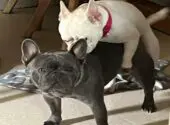Do Pugs and Pitbulls have a special place in your heart? If yes, the Pug Pitbull Mix (Pugbull) is the perfect dog if you want a little bit of both sides — this hybrid dog can be as mellow and affectionate as Pugs but also confident and athletic like Pitbulls.
This article covers everything you need to know about Pugbulls, including their history, personality, care requirements, dietary needs, and common health problems. After reading this guide, this adorable pooch will surely win you over.
Ready? Here we go!
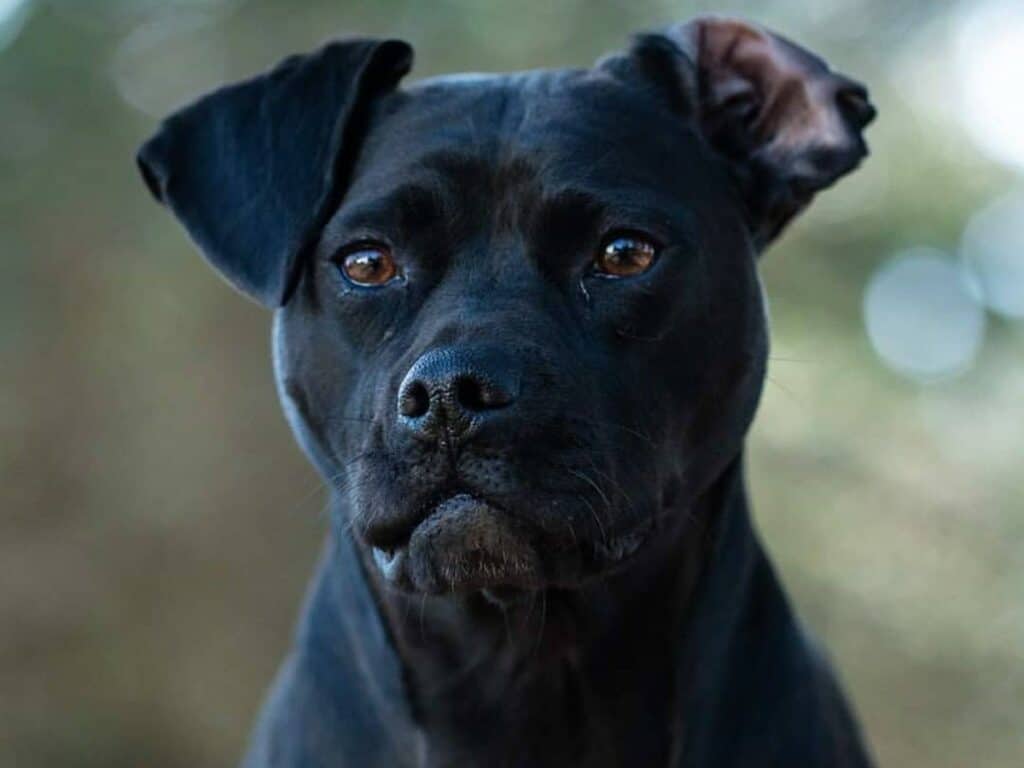
Quick Facts: Pug Pitbull Mix
Height
14 - 16 inchesWeight
23 - 34 poundsLifespan
10 - 13 yearsBreed Size
medium (26-60 lbs.)Breed Type
mixedBreed Group
companion, workingTemperament
anxious, friendly, playful, affectionate, loyal, intelligentGood With
families, other dogs, cats, strangersIntelligence
highShedding
infrequentExercise Needs
lowBarking Level
lowEnergy level
averageDrool Amount
highCoat Type
short, furryCoat Patterns
bi-color, brindleColors
black, gray, red, brindle, blue, brown, black and whiteOther Characteristics
easy to groom, high potential for weight gain, prone to health issues, strong loyalty tendenciesPug Pitbull Mix Highlights
- As the name suggests, the Pug Pitbull Mix is not purebred. American Pitbull Terrier and the Pug are both popular breeds, so it’s no surprise that people have started breeding them together. The result is a mixed-breed dog that doesn’t conform to any standard of appearance or temperament.
- Although they are offspring of Pitbulls, Pugbulls do not necessarily have the same aggressive reputation. They can be some of the most loving and affectionate dogs with the right training.
- These dogs are medium-sized and generally easy to train when they are puppies.
- Pug Pitbull Mix dogs can be prone to ear infections, diabetes, and obesity, among others.
- Given their muscular build, these dogs are unsurprisingly athletic. Owners should ensure these dogs get plenty of exercise so they’re too tired to misbehave.
- Even though Pugbulls are low maintenance, they still require some time and effort.
- Pug Pitbull Mix puppies may be any of many different colors (blue, black, red, brown, gray, brindle, black and white), depending on the exact parentage.
History
While the precise origins of the Pug Pitbull Mix are not well-documented, we can look to the parent breeds for clues about its history.
Pug
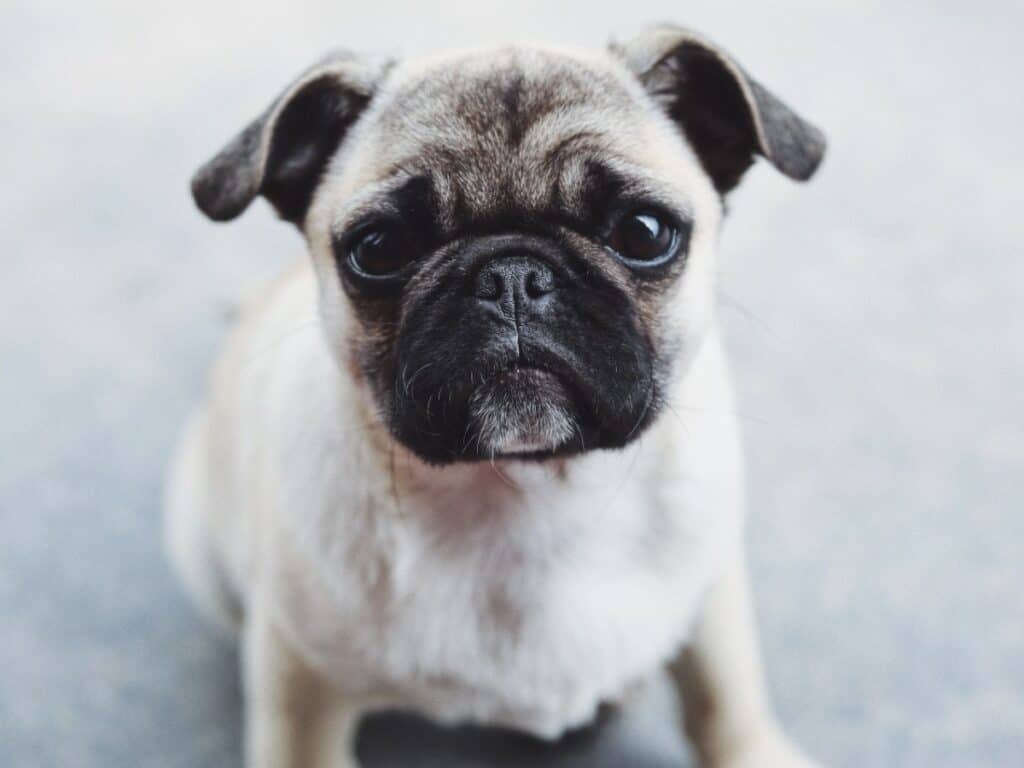
The history of Pugs can be traced back to ancient China, where they were bred as companion dogs for ruling Chinese families. They were given a life of luxury, with guards to protect them.
These dogs eventually spread to other parts of Asia and the world, where they became so popular that Buddhist monks in Tibet kept them as companions.
Pugs arrived in Europe during the 16th century and quickly became a favorite among royal families, including the families of Napoleon Bonaparte and Queen Victoria. The queen‘s love for the Pug inspired and pushed her to establish the Kennel Club, which regulated the breed.
Pugs were brought to the United States in the 19th century and were recognized by the American Kennel Club in 1885.
American Pitbull Terrier
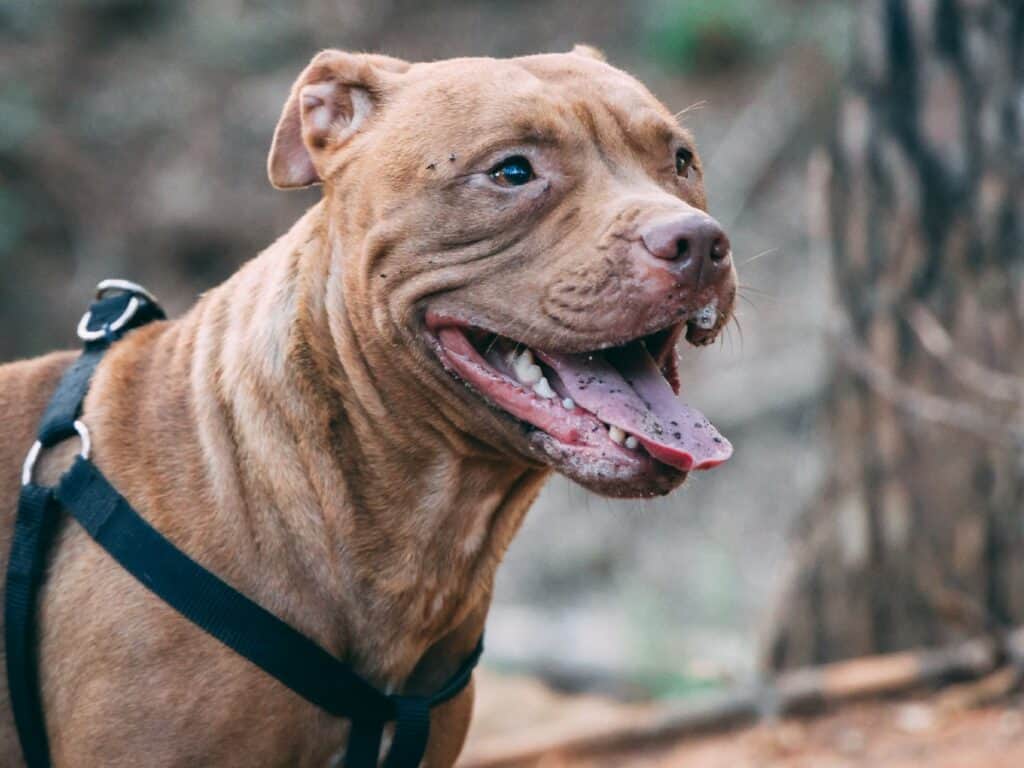
These dogs have had a long and eventful history, serving many different societal roles. They’ve gone from being feared and shunned to being beloved family pets worldwide.
Pitbulls were used for bull baiting and ratting. Their fighting and ratting skills were not good enough for breeders, so they began crossing them with other breeds. The result is a faster and more agile dog. They were later used for various jobs, such as protecting the family from predators, watching the children, and guarding the farm.
These working dogs managed to turn things around when the British brought them to the US. They’re finally seen as loyal and friendly companions.
So, how could a pooch that was bred aggressively also be more tolerant of humans? The answer to this question lies in modifying their characteristics. Back then, these dogs were bred selectively, and those who showed unfavorable characteristics were put down by their handlers.
The Pitbulls we know today are those that were trained to be loving, goofy, and sensitive animals.
Appearance

The Pug Pitbull Mix typically resembles the Pug’s face and the Pitbull’s body . However, there can be some variance in appearance. The signature floppy ears are one trait that is consistent in this dog breed.
Pug Pitbull Mix Size
They typically grow to be 14-16 inches tall and weigh 23-34 pounds, making them medium-sized dogs.
Let’s face it, a medium-sized dog can be just the right size — providing plenty of room to run and play, but not so large as to take up a lot of space.
Pug Pitbull Mix Colors
There can be significant variations in colors among litters of puppies. A Pug Pitbull’s coat color can be blue, black, red, brown, gray, brindle, black or white.
Coat
These dogs are basically little walking balls of fluff. But the good news is they don’t shed much, so you won’t have to worry about your furniture getting covered in dog hair.
Personality
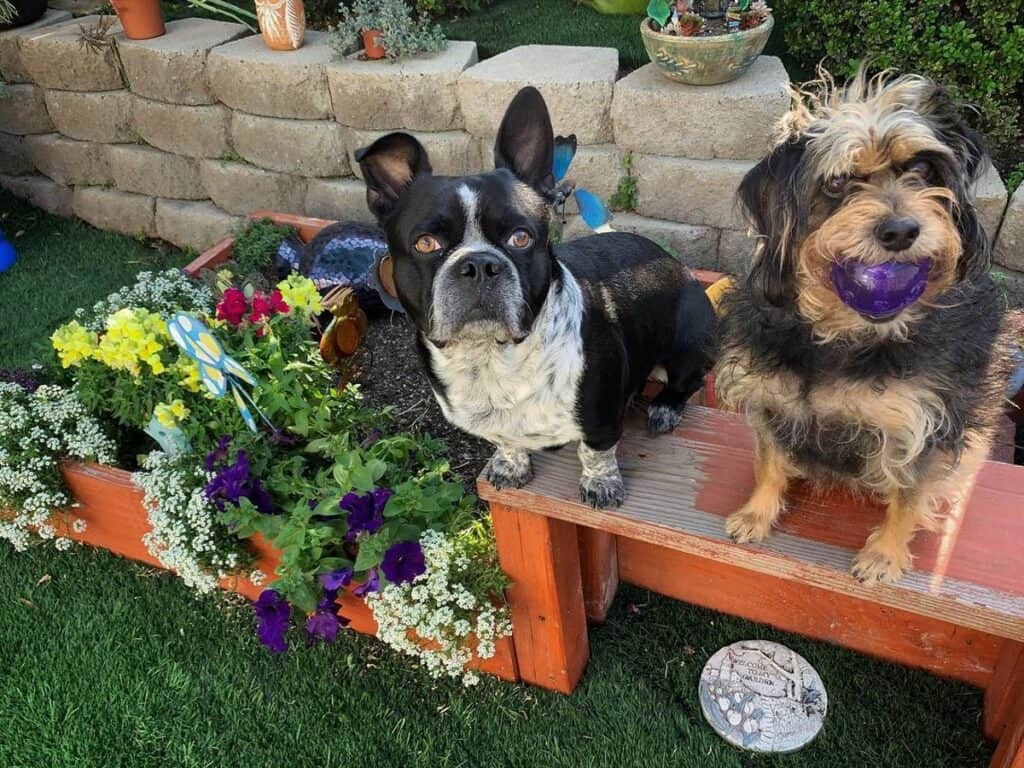

There’s no mistaking a Pug Pitbull mix dog’s personality — friendly, intelligent, adaptable, affectionate, energetic, and anxious.
Friendly
With their friendly personality, these dogs are a joy to be around. They are always happy and excited to see you and are always ready to play. They are also usually well-mannered and don’t get too excited or territorial when meeting new people or other dogs.
Intelligent
Pug Pitbull Mix dogs are intelligent dogs, so they’re more motivated to learn and be successful in training.
They can have a positive impact on your life. They can often understand and respond to commands better than other dog breeds.
Adaptable
These dogs have an adaptable personality, and this has many benefits. For one, it means the Pug Pitbull Mix can handle a lot of different situations. This makes them great companions for people who have a lot of different activities in which they need their dog to participate in.
Affectionate
If you’re looking for a dog with an affectionate personality, you don’t have to look far. They are plenty of Pug Pitbull Mix dogs in rescue groups and shelters that would love to become your new companion.
These dogs are more likely to be friendly to strangers, making adopting or fostering them easier. Also, a dog with such a personality is much easier to care for than one without.
Energetic
Being an energetic breed, they are always a hit if you want a little help keeping your physical activity up. When you have a dog who is always on the move, it can be hard to stay idle.
Additionally, you can count on your Pug Pitbull Mix to make your time spent together enjoyable. They are always up for a game of catch, a roll in the mud, or a race around the house.
Anxious
Not all Pug Pitbull Mix are created equal when it comes to personality. Some are laid back and content, while others are more anxious and restless. You must be willing to do the necessary work to help the dog cope with his anxiety. This may include providing love and attention and setting boundaries and rules that the dog can understand and follow.
Health
A Pug Pitbull Mix that lives on the right diet and gets lots of exercise should have a healthy life. But, like all dog breeds, they’re susceptible to the health issues common in their parent breeds.
Ear Infection
While bacteria might be the number one cause of ear infections in dogs, ear mites, fungus, and yeast can also give your pup’s ears a serious case of the ouchies. Even though ear infections in pups are fairly common, there’s a lot you can do to prevent them. And even if your pup does get an infection, there’s still hope, as most can be cleared up with some medication.
If you don’t give your pup the attention they need, their ear infection might worsen quickly. Symptoms like facial paralysis and balance issues could develop. The best course of action is to take your Pug Pitbull Mix to the vet.
If your furry friend has an ear infection, the vet will use a medicated cleanser to clean the infected ear. The vet may also prescribe anti-inflammatories and antibiotics if necessary.
If your dog is diagnosed with an ear infection, the vet will clean the ear with a medicated cleanser and prescribe any antibiotics and topical medications if necessary.
Diabetes Mellitus
Dogs with diabetes mellitus don’t get enough glucose in their cells, which causes a build-up of sugar in the blood. When there is too much sugar in the blood, it can cause damage to organs and cells.
Having diabetes doesn’t have to be a rough life for your pup. You may notice symptoms before your vet administers a routine blood work, like increased water intake and trips to the bathroom.
Insulin is the recommended treatment for most cases of dog diabetes. No need to be nervous about giving your pup insulin injections — we know it’s a lot at first, but you’ll get used to it quickly enough. Your vet can train you to administer insulin injections to your pup without turning into a total anxiety case.
Obesity
If your pet carries around a few extra pounds, it may be obese. Obesity is a condition characterized by excessive body fat that can adversely lead to health problems and reduced quality of life.
Symptoms of obesity in your canine friend include excess body fat, difficulty breathing, lethargy, lack of mobility, no palpable rib cage, no or little visible waistline, and weight gain.
Many dogs are obese, and the good news is that there are ways to help them slim down. If you want your pet to lose weight, just follow the same weight loss plan humans do: eat less and exercise more! Your veterinarian can tell you how much food to feed your pet and what kinds of exercises are appropriate.
Cataracts
Inherited disease is the most prevalent cause of cataracts in dogs, but there are other causes as well. These include diabetes mellitus and eye injuries. In some cases, cataracts in dogs are simply a result of the aging process.
But don’t worry; your veterinarian can arrange a referral appointment to an ophthalmologist, and your pet will be on its way to better vision. Ophthalmologists can surgically remove cataracts and restore vision that has been failing due to cataracts in your dog.
Epilepsy
Seizures can manifest as an involuntary muscle twitch or uncontrolled shaking and can last from 45 seconds to several minutes.
Seizures can look like twitches or uncontrollable shaking and last from less than a minute to several minutes. Seizures are caused by abnormal, uncontrolled electrical activity in the brain, which can cause changes in behavior and appearance in dogs.
What are the symptoms? The common symptoms are foaming at the mouth, tongue chewing, chomping, drooling, loss of consciousness, muscle twitching, stiffening, jerking, and collapsing.
What is the recommended course of action if your pet experiences a seizure?
First, try not to freak out. Remove your dog from anything that could hurt her, such as the stairs and furniture.
Maintain a distance from your pet’s head and mouth, as she might unknowingly bite. She might also overheat if your pup’s seizure lasts more than a minute or two. For this reason, turn on a fan and cool her paws down with cold water.
And, more importantly, talk to her softly to let her know everything is okay. Once the seizure subsides, give your vet a call.
Lifespan
These lovable Pubulls have been known to stick around for 10 to 13 years. And it’s all thanks to their parent breeds’ long lifespans.
Care
Pug Pitbull Mix dogs are not ideal for sedentary people. Some dogs of this mix may have higher energy levels and require more exercise than others. To keep their energy levels low, take them for long hikes and be sure to give them lots of love and belly rubs along the way.

Because these pups are super smart, they need lots of mental stimulation. Keep their brain power strong by giving them treat-dispensing toys and investing in training.
Also, it’s not ideal to leave your dog unchecked for too long — they might pick up some aggression. Don’t tie your Pug Pitbull Mix up outside all day; that’s just cruel.
Diet
Making sure your Pugbull is getting a well-balanced diet is key to keeping them healthy and happy. Like any other dog, a nutritious diet is essential for overall wellness. So feed them up and watch them thrive.
But remember: you need to be careful not to overfeed your dog as they are prone to putting on weight. Explore various nutritional supplements as well. There are many different options out there for dogs, so do your research and find the one that best suits your pup’s needs.
Grooming
These dogs are well-suited for people who don’t have much time to groom them. But to get them used to being touched up and groomed, start at an early stage.
Obviously, you don’t want your home to be covered in dog hair, so regular brushing is the best hack to keep your home clean. But who has time for that? We recommend the lazy Pugbull owner’s solution: once a week.
Keep their dental hygiene in check by brushing those teeth about twice a week. And when it comes to trimming their nails, every 2-3 weeks should do the trick.
You can give your dog a bath whenever you want; just make sure to give their little ears a good cleaning to avoid infections and other illnesses.
Pug Pitbull Mix Puppies
Before buying a Pug Pitbull Mix puppy, check the breeder’s credentials. You can do this by visiting their website or giving them a call.
Check if the breeder’s facilities are clean and well-ventilated. Also, take a look at the other dogs living there. Are they healthy and happy? If yes, your potential Pugbull pup is apparently well-cared for.
Children and Other Pets
Their adaptable personality is also handy in a home with children. Children are constantly changing and moving around, and a dog who is not adaptable may become stressed out. A Pug Pitbull Mix can relax and enjoy the company of children, regardless of the environment.
Additionally, Pugbull dogs usually get along well with other dogs and cats. This makes them perfect candidates for families with other pets.
Rescue Groups
Pugbulls and other Bulldog mixes have had a tough time throughout history. These dogs were treated badly in the 19th and 20th centuries, so few people pick them as their first choice.
They are often sold by breeders for a high price, but many end up in shelters or rescue groups. If you adopt a Pug Pitbull Mix from one of the shelters below, you get a new best friend and the fulfilling feeling of doing a selfless act. All you need to provide is love and a comfy space for your pup to call home.
Pugs U Gotta Save (PUGS) – Virginia
Bluegrass Pug Rescue (BPR) – Kentucky
Compassionate Pug Rescue (CPR) – Florida
Pacific Pug Rescue (PPR) – Oregon
Pug Pitbull Mix FAQS
How big does a Pug Pitbull Mix get?
As medium sized-dogs, they typically grow to be 14-16 inches tall and weigh 23-34 pounds.
Are Pug Pitbull Mix dogs aggressive?
Don’t let the muscular exterior fool you, this breed may look like they’re strong and aggressive, but they’re really sweet-natured. Perfect for families with kids and other pets, Pugbulls are gentle souls at heart.
Do Pug Pitbull Mix dogs shed a lot?
These dogs have low shedding levels, so you won’t have to constantly remove hair from your furniture or floors.
Are Pugbulls hypoallergenic?
Unfortunately, Pitbulls are not hypoallergenic. If you’re looking for a furry friend but are allergic to dander, this may not be the best breed for you.
Can Pug Pitbull Mix dogs be left alone for long periods?
Generally, it’s best for Pug Pitbull Mixes to be left alone for shorter periods (four hours) than for extended periods (longer than four hours). This is because these dogs can become restless and anxious from spending too much time alone. If you need to be at work most of the day, set up a system where you can check on your dog periodically.
Pug Pitbull Mix Fun Facts
- A Pug Pitbull Mix is also called Pugbull, Pugabul, Pugbull Terrier, and Pit Pug.
- Sone Pug Pitbull dogs have a high prey drive which, if left unchecked, can result in them attacking smaller animals. Training can help to control this behavior.
- Although all dogs drool to some degree, the drool amount in Pug Pitbulls can be quite high. If you’re someone who loves a drooling Pug Pitbull, you should be prepared to clean up after them constantly.
References
Qadri, K., Ganguly, S., Praveen, P. K., & Wakchaure, R. (2015). Diabetes mellitus in dogs and its associated complications: A review. Int. J. Rec. Biotech, 3(4), 18-22.
Urfer, S. R., Greer, K., & Wolf, N. S. (2011). Age-related cataract in dogs: a biomarker for life span and its relation to body size. Age, 33(3), 451-460.


